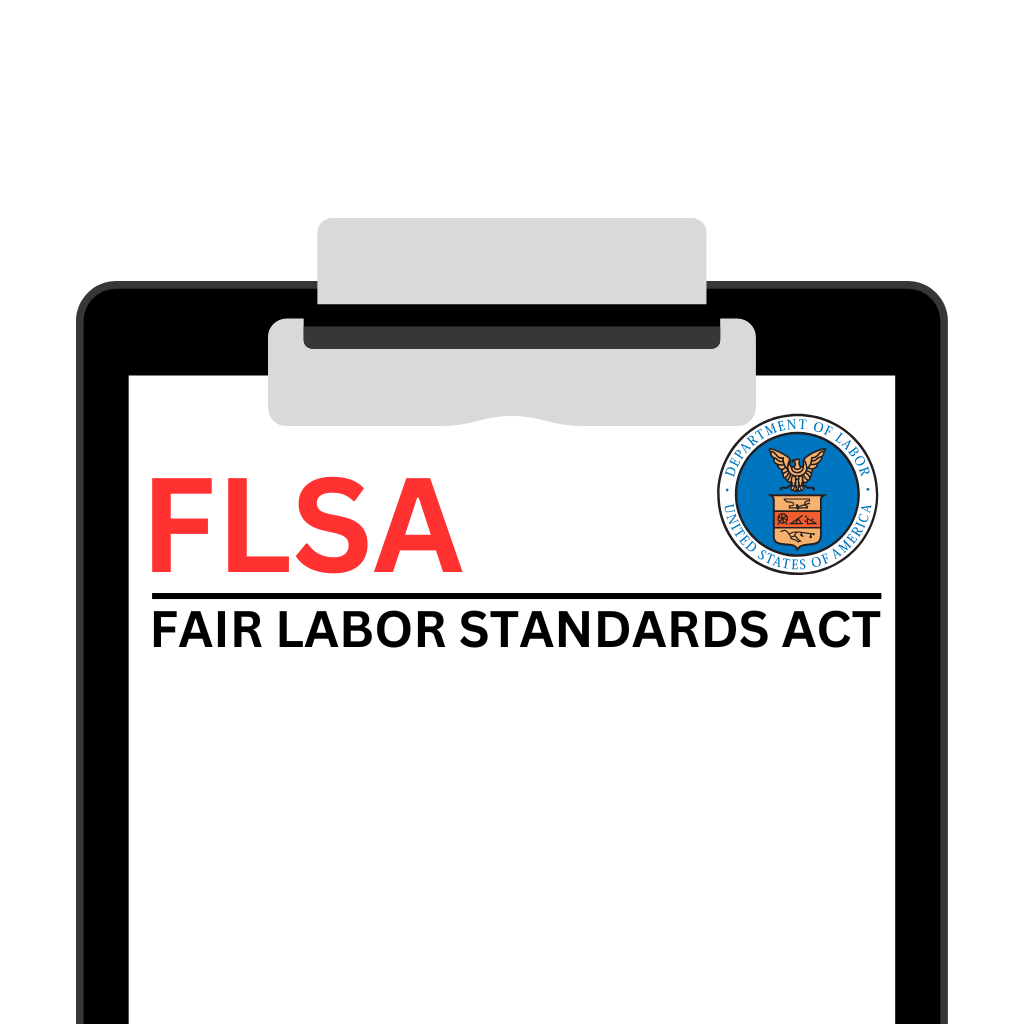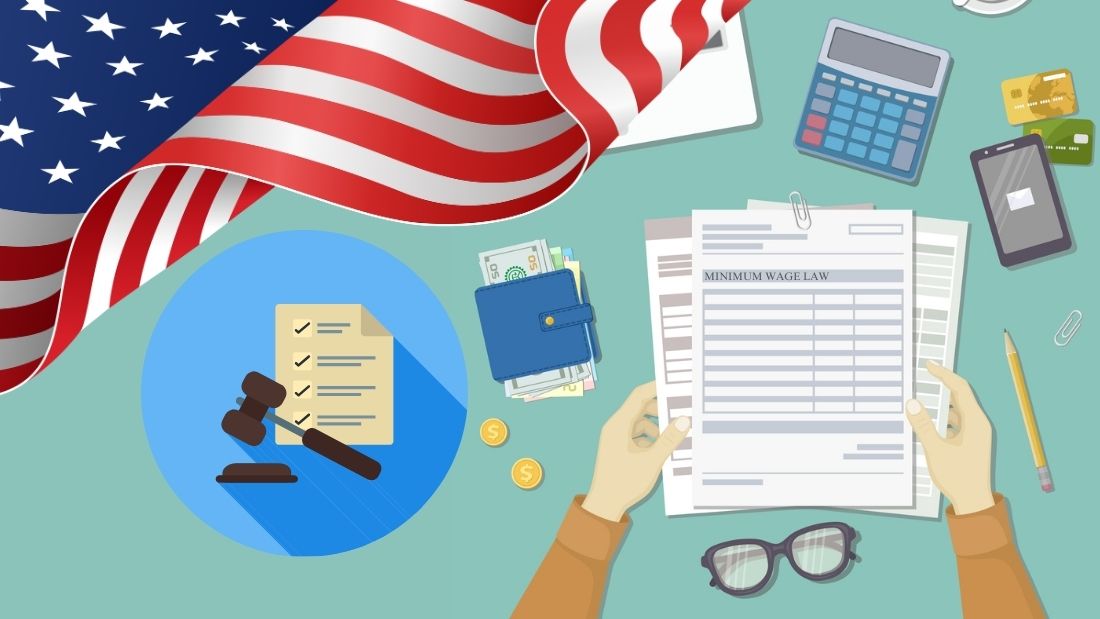This blog provides an overview of minimum wage laws in the United States with a detailed state-by-state breakdown. The minimum wage is a fundamental aspect of economic policy, establishing the lowest salary that employers can legally pay their workers. This regulation is crucial not only for protecting workers from unfairly low wages but also for setting a financial baseline that supports the cost of living across diverse regions.
The impact of minimum wage extends beyond individual earnings, influencing broader economic health, consumer spending, and the dynamics of poverty and inequality.
In 2024, as we see varying minimum wage rates across the country, understanding these differences and the legislative frameworks governing them is essential. By examining the nuances of each state’s approach, we aim to provide insights into how these policies affect the economic and social fabric of communities, impacting millions of American workers.
Disclaimer: Please note that the information provided in this blog post is accurate as of the time of writing. Laws and regulations are subject to change over time. While we strive to keep our content as up-to-date as possible, we encourage readers to consult official government resources or legal professionals for the most current information. This blog is intended for informational purposes only and should not be taken as legal advice.
Federal Minimum Wage Overview
The federal minimum wage is the lowest wage rate that an employer can legally pay their employees throughout the United States. It acts as a baseline below which no state wage can fall, although states are free to set higher minimum wages. As of 2024, the federal minimum wage stands at $7.25 per hour, a rate that has remained unchanged since 2009.
This section of the wage has been a critical factor in wage negotiations and labor policies across the country.
Legislative Background
The federal minimum wage was first established in 1938 under the Fair Labor Standards Act (FLSA). Originally set at $0.25 per hour, the wage has been adjusted numerous times in response to changes in the economic landscape and cost of living. Key amendments to the FLSA have included periodic increases to the wage rate and expansions in coverage, which have progressively included more workers under its protection.

Adjustments to the Federal Minimum Wage
Adjustments to the federal minimum wage are typically made through legislative action by Congress and require the approval of the President. These changes are often influenced by economic indicators, political climates, and advocacy from labor groups.
Despite the existence of a formula for periodic adjustments in some states, no such automatic adjustment mechanism exists at the federal level; all changes must be explicitly legislated. The absence of an increase since 2009 has led to significant debate regarding the wage’s ability to meet the basic living needs of American workers.
State-by-State Minimum Wage in 2024
This section offers a detailed, alphabetical listing of the 2024 minimum wages for each state. As we explore these figures, we’ll see how each state’s economic strategies and legislative decisions impact workers and local economies, reflecting the diverse socio-economic landscapes across the United States.
Arkansas
State Minimum Wage Law: Yes – Learn more
Minimum Wage:
- Less than 4 employees = $7.25
- 4 or more employees = $11.00
Tipped Wage: $2.63
Connecticut
State Minimum Wage Law: Yes – Learn more
Minimum Wage: $15.69
Tipped Wage:
- Wait Staff $6.38
- Bartenders $8.23
Georgia
State Minimum Wage Law: Yes – Learn more
Minimum Wage:
- $7.25 (Federal Minimum)
- $5.15 (For FLSA Exceptions)
Tipped Wage: $2.13
Minnesota
State Minimum Wage Law: Yes – Learn more
Minimum Wage:
- Companies with gross revenue less than 500k = $8.85
- Companies with gross revenue of more than 500k = $10.85
Tipped Wage:
- Companies with gross revenue less than 500k = $8.85
- Companies with gross revenue of more than 500k = $10.85
Mississippi
State Minimum Wage Law: No
Minimum Wage: $7.25 (Federal Minimum)
Tipped Wage: $2.13
Nevada
State Minimum Wage Law: Yes – Learn more
Minimum Wage: $12.00 (From July 1, 2024)
Tipped Wage: $12.00 (From July 1, 2024)
New Hampshire
State Minimum Wage Law: No
Minimum Wage: $7.25 (Federal Minimum)
Tipped Wage: $3.27
New York
State Minimum Wage Law: Yes – Learn more
Minimum Wage:
- New York City = $16.00
- Long Island & Westchester = $16.00
- Rest of New York State = $15.00
Tipped Wage: Varies – Learn more
North Carolina
State Minimum Wage Law: No
Minimum Wage: $7.25 (Federal Minimum)
Tipped Wage: $2.13
North Dakota
State Minimum Wage Law: No
Minimum Wage: $7.25 (Federal Minimum)
Tipped Wage: $2.13
Oklahoma
State Minimum Wage Law: No
Minimum Wage: $7.25 (Federal Minimum)
Tipped Wage: $2.13
Oregon
State Minimum Wage Law: Yes – Learn more
Minimum Wage:
- Standard = $14.20
- Portland = $15.45
- Non-Urban Counties = $13.20
Tipped Wage:
- Standard = $14.20
- Portland = $15.45
- Non-Urban Counties = $13.20
Pennsylvania
State Minimum Wage Law: No
Minimum Wage: $7.25 (Federal Minimum)
Tipped Wage: $2.83
South Carolina
State Minimum Wage Law: No
Minimum Wage: $7.25 (Federal Minimum)
Tipped Wage: $2.13
Washington State
State Minimum Wage Law: Yes – Learn more
Minimum Wage:
- Standard = $16.28
- SeaTac = $19.71
- Seattle = $19.97
- Tukwila = $20.29
Tipped Wage: $16.28
West Virginia
State Minimum Wage Law: Yes – Learn more
Minimum Wage:
- Less than 6 employees = $7.25
- 6 or more employees = $8.75
Tipped Wage: $2.62
Wisconsin
State Minimum Wage Law: No
Minimum Wage: $7.25 (Federal Minimum)
Tipped Wage: $2.33
Wyoming
State Minimum Wage Law: No
Minimum Wage: $7.25 (Federal Minimum)
Tipped Wage: $2.33
Analysis of Changes in 2024
States with Increased Minimum Wages
In 2024, over half of the states in the United States are scheduled to experience a rise in their minimum wage rates. This widespread increase reflects a growing recognition of the need to adjust wages in line with the cost of living and inflation rates.
The states witnessing these increases include:
Alaska, Arizona, California, Colorado, Connecticut, Delaware, Florida, Hawaii, Illinois, Maine, Maryland, Michigan, Minnesota, Missouri, Montana, Nebraska, Nevada, New Jersey, Ohio, Oregon, Rhode Island, South Dakota, Vermont, Washington, Washington, D.C.
Each of these states has specific legislative, economic, or voter-driven reasons for the adjustments, aiming to improve living standards for workers and align more closely with regional economic realities.
Highest and Lowest State Minimum Wages
As of 2024, the spectrum of minimum wages across the United States varies significantly, influenced by differing economic factors and legislative environments.
- Lowest Minimum Wage: Georgia and Wyoming continue to have the statutory minimum wage set at $5.15 per hour, the lowest in the nation. However, since these states are covered by the Fair Labor Standards Act (FLSA), employers must comply with the federal minimum wage of $7.25 per hour, which supersedes the state rate for most workers.
- Highest Minimum Wage: Washington State leads among the states with the highest hourly minimum wage at $16.28. However, Washington, D.C. outpaces all with a remarkable minimum wage of $17.00 per hour, reflecting its unique economic and legislative environment and the high cost of living in the nation’s capital.
Legislative Trends and Future Projections
Understanding the legislative dynamics that drive changes in minimum wage laws is crucial for predicting future trends and preparing for their implications. This section of the blog examines the ongoing legislative trends affecting state minimum wages and offers insights into potential future changes.

Current Legislative Trends
Recent years have seen a significant shift toward increasing minimum wage rates across many states. This is often driven by legislative actions and ballot initiatives that reflect growing public support for wage increases. Key trends include:
- Indexing to Inflation: Several states have adopted policies that automatically adjust minimum wages annually based on inflation. This approach helps ensure that wages keep pace with the cost of living without requiring new legislative action each year.
- Gradual Increases: Many states have legislated gradual increases over several years, providing businesses time to adjust and mitigating immediate economic shocks.
- Regional Collaboration: Some neighboring states are considering or have started to align their minimum wage policies, which can reduce cross-border economic disparities and competition.
Predictions for Future Changes
Looking ahead, several factors are likely to influence the trajectory of minimum wage legislation:
- Economic Recovery Post-Pandemic: As the economy continues to recover from the COVID-19 pandemic, states might adjust their minimum wage policies to support recovery and stimulate economic growth.
- Political Shifts: Changes in state legislatures and governorships can lead to shifts in policy priorities, potentially accelerating or slowing down the pace of wage increases.
- Public Advocacy: Increasing activism and public advocacy for living wage policies could drive more states to adopt higher minimum wages or index them to inflation.
Anticipated Challenges and Opportunities
Future legislative changes will need to balance economic growth with the needs of low-wage workers. Anticipated challenges include dealing with inflationary pressures and the varying economic conditions across states. However, these changes also present opportunities to improve economic equality and worker welfare.
The Role of Workforce Management Software
In the ever-evolving landscape of minimum wage laws across different states, businesses face the challenge of staying compliant while managing their labor costs effectively. This is where Workforce Management Software like the one by Softworks becomes indispensable. By integrating advanced technology into daily operations, businesses can adapt more smoothly to changes in wage regulations and enhance overall efficiency.
Optimizing Labor Costs
Companies can optimize their labor costs without sacrificing quality or productivity. The software’s scheduling capabilities allow for precise labor planning, ensuring that staffing levels are aligned with demand while adhering to budget constraints. This precise management helps businesses avoid overstaffing during off-peak times and understaffing during peak hours, which is crucial in industries with fluctuating workloads.
Enhancing Employee Satisfaction
The software plays a critical role in enhancing employee satisfaction by ensuring fair compensation and transparent scheduling practices. The system allows employees to access their schedules and pay information easily, fostering a transparent workplace culture that values and respects worker rights. Happy, well-compensated employees are more likely to be productive, loyal, and engaged in their work.
Analytical Insights for Future Planning
The analytical tools provided by software like Softworks Workforce Management Software offer valuable insights that aid in strategic planning. Businesses can analyze trends in labor costs, productivity, and compliance issues, enabling them to make informed decisions about future workforce needs and budget allocations. These insights help companies anticipate changes in labor laws and adapt their strategies accordingly.
By integrating Softworks Workforce Management Software, businesses can not only comply with evolving minimum wage requirements but also improve operational efficiency, reduce costs, and enhance employee satisfaction. This strategic integration positions businesses to thrive in a dynamic economic environment, ensuring they are prepared for future changes and challenges in wage legislation.
Learn more: Workforce Management Software by Softworks
Conclusion
This blog has highlighted the pivotal role of minimum wage laws in shaping the economic and social fabric across different states in 2024. As we look ahead, legislative trends and public advocacy are likely to drive further reforms. Employers must navigate these changes carefully to maintain compliance and optimize operational efficiency.
Tools like Softworks Workforce Management Software are essential in adapting to these dynamics, ensuring that businesses can meet both current and future challenges with confidence.
For a closer look at how Softworks can help your business stay ahead of minimum wage changes and enhance workforce management, request a demo today and experience the benefits firsthand.
Sources
- State Minimum Wage Laws, U.S Department of Labor, Wage and Hour Division (.gov)
- Minimum Wages for Tipped Employees, U.S Department of Labor, Wage and Hour Division (.gov)
- Wage and Hour Info, Alabama Department of Labor (.gov)
- Wage And Hour, State of Alaska, Department of Labor and Workforce Development Wage and Hour, Alaska Department of Labor (.gov)
- Minimum STUFF Wage Information, Industrial Commission of Arizona (.gov)
- Minimum Wage and Overtime, Arkansas Department of Labor and Licensing (.gov)
- Minimum Wage Frequently Asked Questions, State of California Department of Industrial Relations (.gov)
- Wage and Hour Laws, Colorado Department of Labor and Employment (.gov)
- Governor Lamont Announces Connecticut’s Minimum Wage Will Increase to $15.69 in January Under Its First-Ever Economic Indicator Adjustment, Connecticut’s Official State Website (.gov)
- Minimum Wage, Delaware Department of Labor (.gov)
- Notice to Employees – Minimum Wage in Florida, Floridajobs.org
- Minimum Wage, Georgia Department of Labor (.gov)
- Minimum Wage and Overtime, State of Hawaii Wage Standards Division (.gov)
- Hourly Minimum Wage Rates by Year, Illinois Department of Labor (.gov)
- Minimum Wage Law, Indiana Department of Labor (.gov)
- New Minimum Wage Increases, State of Maine Department of Labor (.gov)
- Maryland Minimum Wage and Overtime Law, Maryland Department of Labor
- Massachusetts law about minimum wage, Mass.gov
- Minimum Wage Set to Increase January 1, 2024, Michigan Labor and Economic Opportunity (.gov)
- Minimum Wage in Minnesota, Minnesota Department of Labor and Industry (.gov)
- Minimum Wage, Missouri Department of Labor and Industrial Relations (.gov)
- Montana’s Minimum Wage, Montana Department of Labor and Industry (.gov)
- Minimum Wage in Nebraska, Nebraska Department of Labor (.gov)
- Changes coming to Nevada’s minimum wage, overtime effective July 1, 2024, State of Nevada Department of Business & Industry (.gov)
- New Jersey’s Minimum Wage to Increase to $14.13/Hour for Most Employees on Jan. 1, New Jersey Department of Labor & Workforce Development (.gov)
- Minimum Wage Information, New Mexico Department of Workforce Solutions (.gov)
- Minimum Wage, New York State Department of Labor (.gov)
- 2024 MINIMUM WAGE, State of Ohio Department of Commerce (.gov)
- Minimum wage increase schedule, Oregon Bureau of Labor And Industries (.gov)
- Governor McKee Signs Legislation Raising the Minimum Wage in Rhode Island, RI.gov
- South Dakota Minimum Wage, South Dakota Department of Labor and Regulation (.gov)
- The Vermont Department of Labor Announces Minimum Wage Increase Starting January 2024, State of Vermont Department of Labor (.gov)
- Code of Virginia, § 40.1-28.10. Minimum wages, Virginia Law (.gov)
- Office of Wage-Hour Compliance, Washington D.C. (.gov)
- Minimum Wage, Washington State Department of Labor and Industries (.gov)
- Minimum Wage & Maximum Hours, West Virginia Division of Labor (.gov)
About Tomislav Rucevic
Tomislav Rucevic, an SEO Specialist at Softworks, stands out as more than just a marketer. He’s a fervent writer and influential thinker passionate about Workforce Management, HR, and work-life dynamics. Holding an MBA in Marketing, Tomislav excels in creating content that delves into the complexities of the modern workplace.
His dedication to writing on these topics is highlighted in his MBA thesis, which examined the link between Employee Motivation and Quality Improvement. At Softworks, he expertly merges his SEO skills with his writing prowess, contributing to the company’s digital success and advancing discussions on enhancing work environments and achieving work-life balance.








